NY-NJ Harbor Estuary: Public Input
Raritan River Basin
|
NEW ESRI StoryMaps: What's On Our Shelves & NWNL Song Library & No Water No Life ESRI |
Raritan River Basin
Bill Schultz
NY-NJ Raritan Baykeeper
Rob Pirani
HEP Program Director
Alison M. Jones
NWNL Director and Photographer
NY-NJ Baykeeper, Bill Shultz, hosted this community meeting for the NY-NJ Harbor Estuary Program [HEP] to hear residents’ concerns and priorities regarding water quality, habitat and public access. This meeting was the first of 15 to be held over 12 weeks to synthesize local opinions into an action agenda.
“We’re traveling around the NY-NJ Harbor Estuary essentially to create a to-do list,” said Rob Pirani, Program Director for HEP, which is part of the Hudson River Foundation, a New York City science and research group.
Raritan Bay and the rest of the NY-NJ Harbor Estuary are finally being valued and used by more people than ever before. However, many challenges face efforts to improve the Harbor Estuary’s recreational resources serving 14 million people. HEP faces issues of dense development around the estuary, limited funding and insufficient political attention.
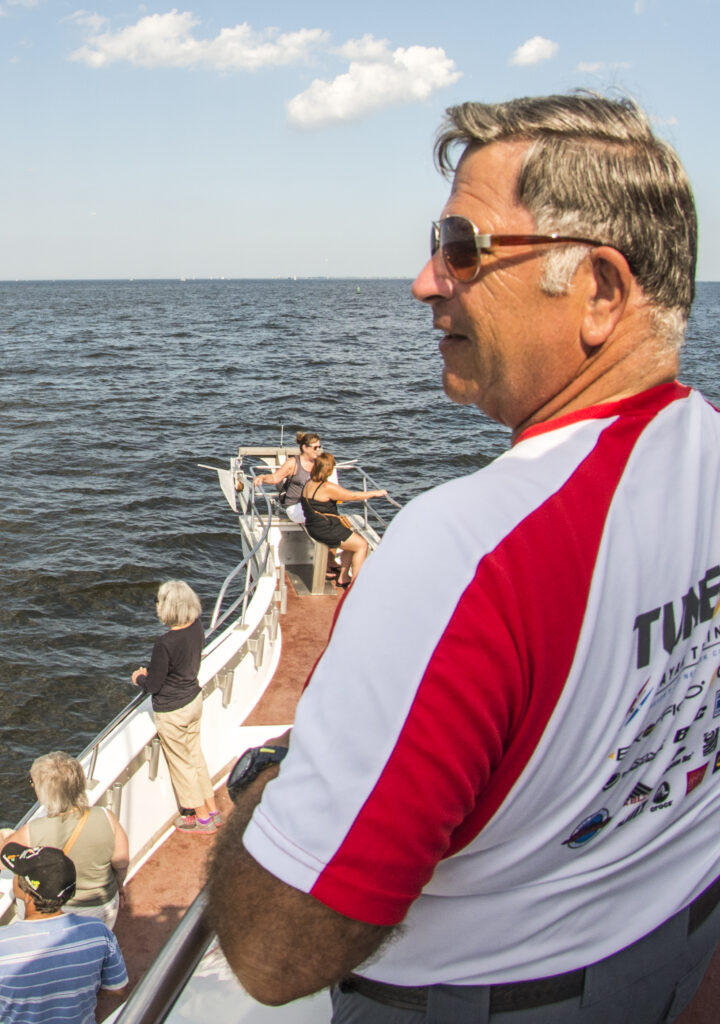
HEP’s MISSION
HEP’S CHALLENGES
ASSESSING & FUNDING WATER QUALITY
Q&A ON RARITAN BAY POLLUTION
Q&A ON WATER QUALITY ISSUES
Q&A ON RESTORATION & HABITAT IMPROVEMENT
PUBLIC ACCESS TO WATER
VULNERABILITY OF MARINAS
PUBLIC EDUCATION
Water test results need to be shared across municipalities. We all share the same water. -- Audience
The need for science is imperative when addressing complicated and cross-jurisdictional estuaries like New Jersey’s Raritan Bay and New York Harbor. -- Bill Schultz
All images © Alison M. Jones, unless otherwise noted. All rights reserved.
BILL SCHULTZ We’re here because we care about Raritan Bay and Estuary. We like to characterize it as “the largest public space in the nation’s biggest city.” The Bay has 1,600 miles of shoreline, 250 square miles of open water, and 50-80 billion gallons of water. For people living around the Bay, it’s a very important shared resource.
The mission of the NY-NJ Harbor Estuary Program [hereafter, HEP] is to help people and wildlife benefit from improved water quality. Authorized by the federal government and the Clean Water Act, HEP connects people with wildlife resources. It also connects New York and New Jersey with the EPA as they create committees to manage this resource. EPA has also helped 27 other US estuaries with their stewardship programs.
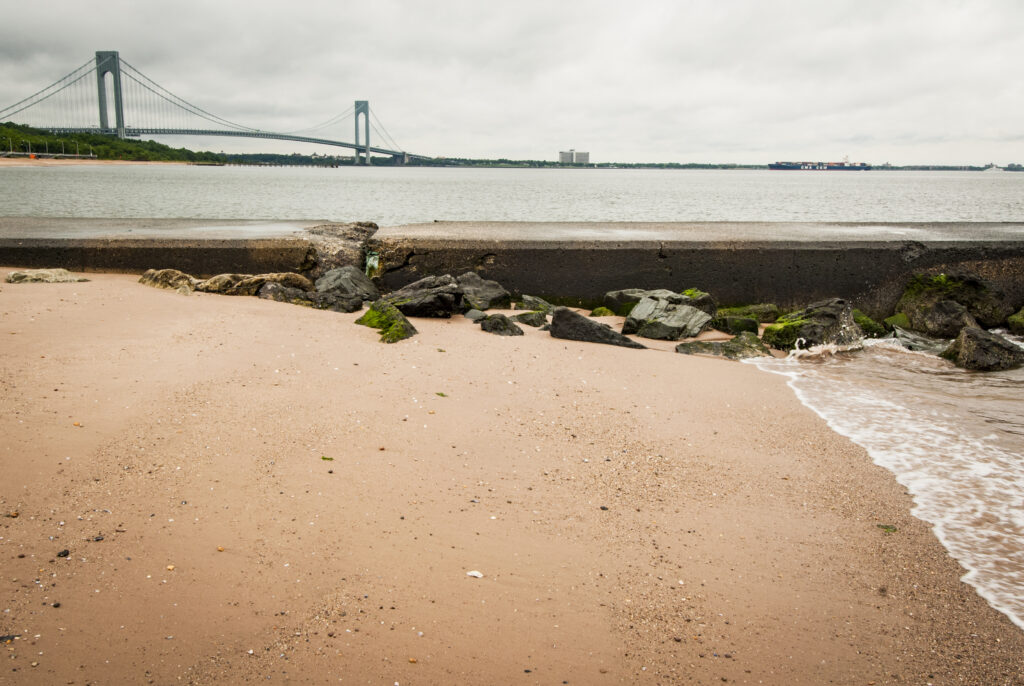
The need for science is imperative when addressing complicated and cross-jurisdictional estuaries like New Jersey’s Raritan Bay and New York Harbor. These two states, with 14 counties and hundreds of municipalities, have an estimated 14 million people surrounding the estuary. About 5 million people live within a 10-minute walk of the waterfront. Fortunately, the EPA decided to implement the Clean Water Act to create fishable, swimmable. Here, this task involves 25 municipalities and 312,000 residents in the Raritan Bay and Sandy Hook Bay watersheds.
This task needed the HEP partnership, not just one agency. HEP pulls together federal agencies, state government, local government, civic groups and the public to develop and implement their shared goals. In 2009/2010, HEP set 5 goals which we continue to use. As we hear from the public – that includes you – and technical stakeholders, we may revise these goals and come up with new goals. But they suffice for now.
ROB PIRANI Geographically, HEP focuses on our core waters, including the Raritan Bay, and other direct drainages – from the first Hudson River dam downstream to the Tappan Zee Bridge. But we also focus on the entire watershed. Thus, for instance, we met folks in Newburgh NY to discuss Upper Hudson watershed improvements, since that region provides about 80% of the Estuary’s water.
Our work focuses on three areas where we can add value. Convening stakeholders is our first step. Yesterday, we held a Restoration Conference with about 200 folks working on the front line of habitat restoration. We’re bringing people together to support natural resource managers; share the latest science; and hopefully find agreement as we meet civic groups and the public.
We also support science in this estuary. We give out grants and convene research scientists, including those now in Sandy Hook labs studying the effects of toxins on Raritan Bay fish. We also identify management challenges. Then we ask people to help us address those issues – as we’re doing tonight. Our work with the City of Perth Amboy – creating a green infrastructure plan – models the benefits of reducing their combined-sewer overflow events. We work directly with our partners to meet our goals for water-quality levels and safe habitats for 14 million people living in big, dense urban cities to a wide range of suburbs and towns.
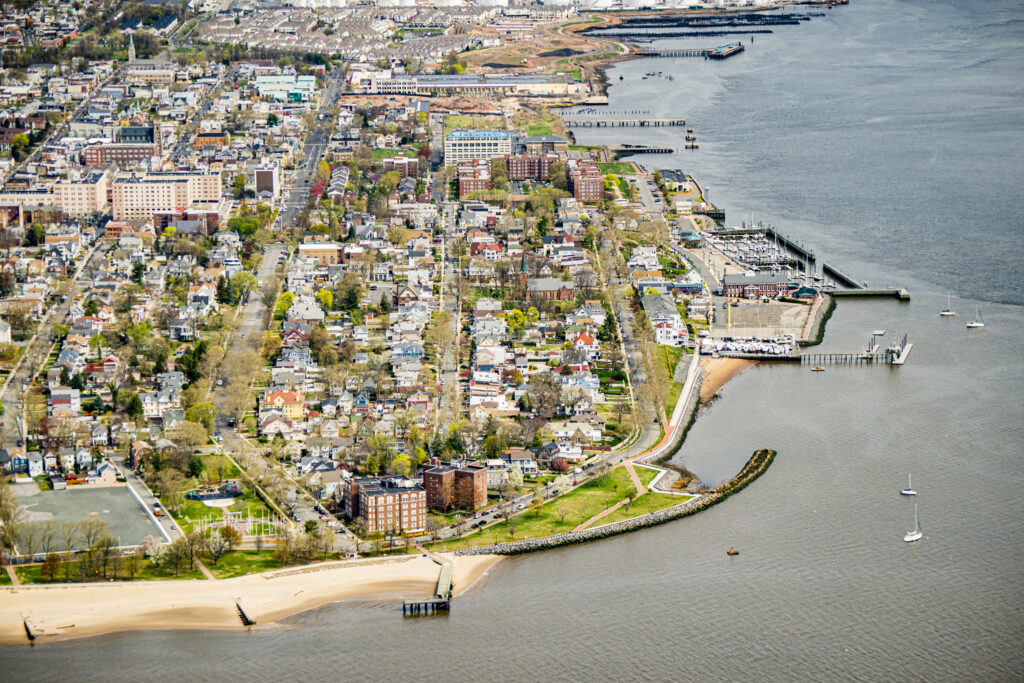
ROB PIRANI One big issue here is the high amount of toxic sediment in the bottom of the waterways. Some of that is being cleaned up, but it’s still in the system, affecting what we can do and our enjoyment of the water. One challenge in this estuary is that its many small bays, inlets and tributaries face pollutants from sewage treatment plants and other toxins, concentrated in those waterways.
We’re a very diverse set of communities. Some communities along the waterfront have a disproportionate amount of poor people without access to our political system. Our challenge is to make sure everybody can enjoy the Raritan Bay and that everyone sees improvements going forward. Obviously, there are other challenges; and climate change just adds more stresses to the system.
We’ve tentatively identified several major challenges to the Raritan Bay and the Estuary.
Obviously, the weather’s getting warmer and water in Raritan Bay will get warmer. We’ll have continuing increases in extreme weather, including rainfall events and big storms. Sea level is rising and has been for at least the last 100 or so years. Projections are for up to 2- 4’ rises in New York City; and that’s the low end of the spectrum for the next 80 years.
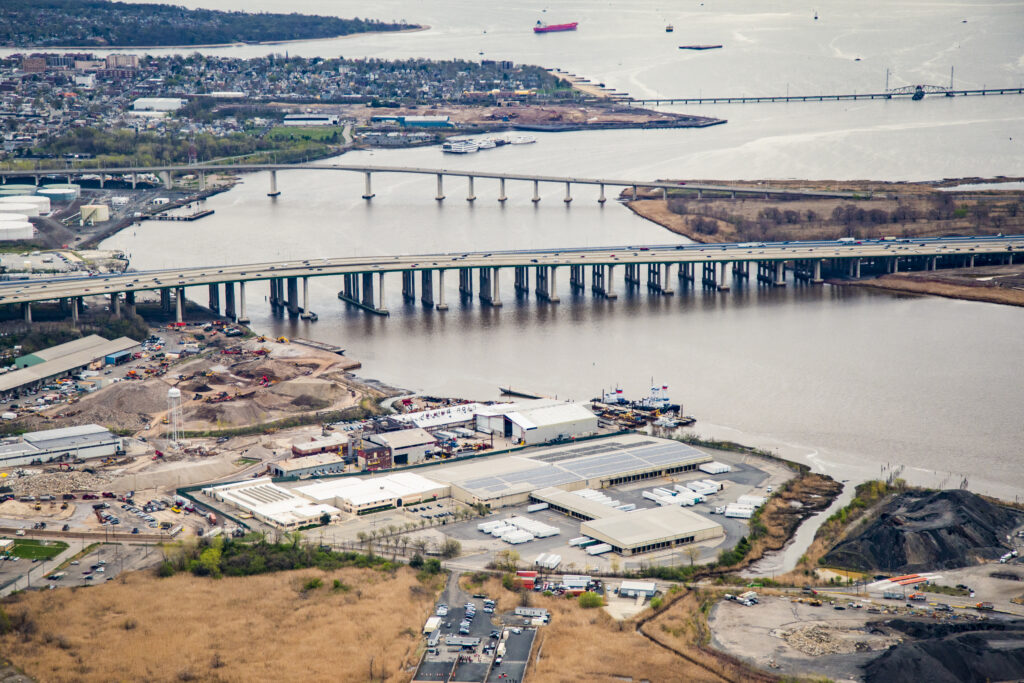
AUDIENCE How are you funded?
BILL SCHULTZ Primarily we’re funded by the EPA through the Clean Water Act, which allocates us an amount from $600,000 to $800,000. That’s then matched by polluting parties who’ve caused environmental damage and used primarily for scientific research. We also get some government grants.
AUDIENCE What kinds of things do you to that require more involvement by people?
BILL SCHULTZ We’re here with you tonight to determine where to spend our money. We’ve created an Action Agenda to establish priorities that reflect wishes of the public, such as those expressed in these public meetings. We also talk to stakeholders in government agencies that we partner with. Through that process, we hope to come up with a manageable list of priorities that reflect interests of people across states involved.
We need you to help us spread that money we receive. Things cost money. Civic organizations sense what local folks are interested in doing, so we support them in many ways. We buy grants for public programs on the waterfront, to celebrate the water and give people those experiences We fund citizen science, volunteer cleanups and similar things – but it’s never enough. We’re always hopeful we’ll get more so we can be more involved with the public.
We all know there’s not enough money in the world to do what we all want to do, so it takes everybody’s involvement; cooperation between levels of government; people working together and rowing in the same direction – and citizens contributing their time and effort, including tonight’s approach to decision-making. So, thank you for taking the time to come here tonight!
A quick snapshot of our focus shows water quality in general improved with the creation of the 1972 Clean Water Act – when, across the country, we decided we cared about water quality. But it’s only generally better in terms of dissolved oxygen that’s important to fish and wildlife, and in terms of the pathogens that come out of the sewer pipes and through sort of stormwater flows. Those conditions are important qualifiers in terms of whether a place is safe enough to swim in (for fish and people) from the shore or from a boat.
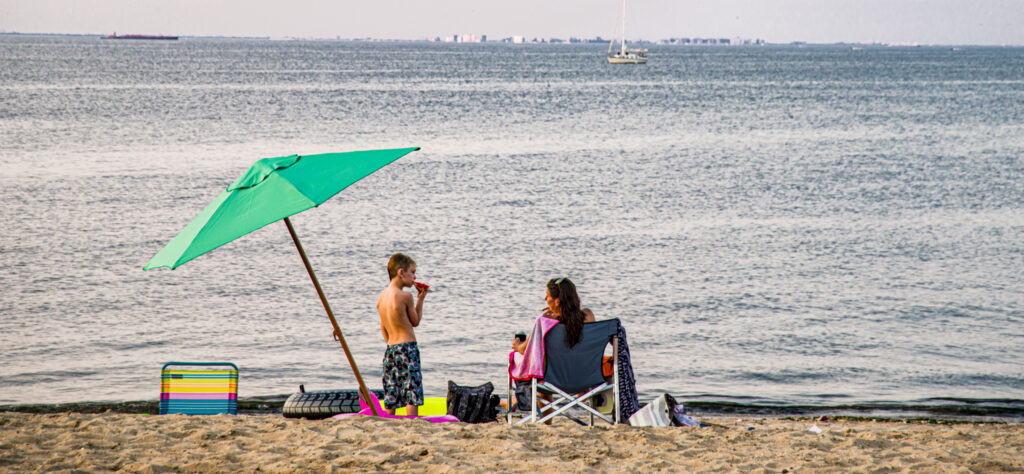
But our assessments are only for an average day. When you go swimming on a particular day, you want to know whether that water is safe that day for you or your kids. We know there are still persistent problems throughout the estuary. We also know that our ability to measure water quality is limited, particularly along the shoreline, which is important for recreation and fish nurseries.
There are big challenges for the estuary as a whole – as well as here in Keyport, Monmouth County and the Bay Shore. What do you think we should pay attention to? What do you consider to be an important benefit from cleaner water: swimming? boating? fishing?
AUDIENCE I’m concerned there are still towns with combined sewer and drain-water overflows.
BILL SCHULTZ Right! Here in this part of New Jersey, there are 21 municipalities that have combined sewer overflows [hereafter, CSO’s]. Let me explain CSO’s.
In older U.S. municipalities, water from your home and sewage pipes is combined with stormwater from the street drains. Because there’s limited capacity at most of community sewage treatment plants, when there are big rain events, utilities open a valve, allowing both untreated, raw sewage and rainwater to go into the bay. In New York City, just a half-inch of rain can flood to an extent that triggers a CSO event that leads to both immediate and long term pollution. That drastically changes water quality.
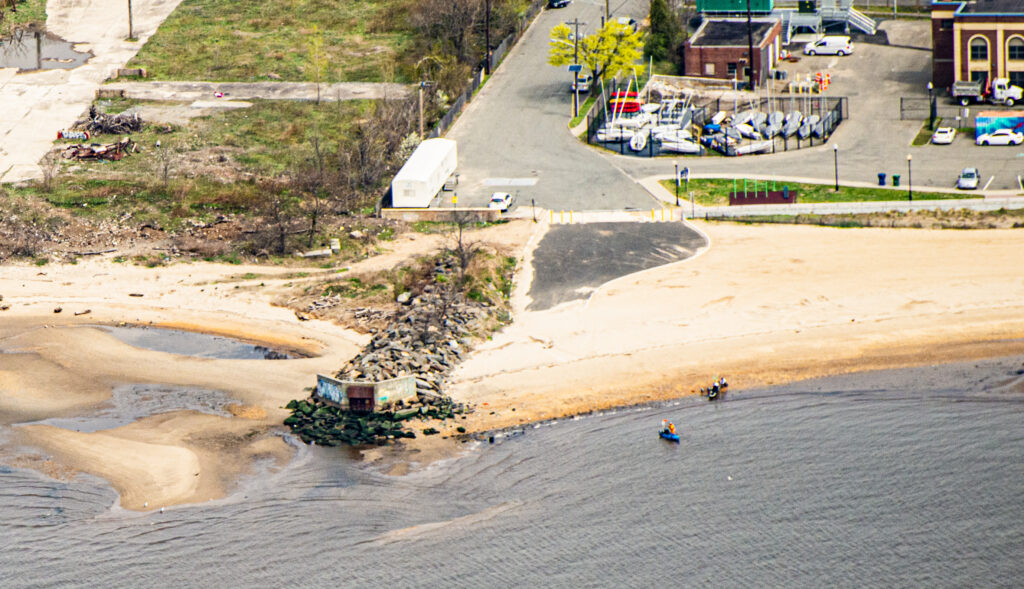
Yes, it’s a big issue! New Jersey recently issued draft permits for municipalities and utilities to work on together to control their plants and thus address CSO’s. On the other side of the Bay, New York City has already started a CSO planning process. They’re now holding public hearings for a draft plan. Locally, Perth Amboy and Staten Island have CSO issues.
AUDIENCE Where can I find the list of those 21 municipalities that have CSO events?
BILL SCHULTZ Go to the New Jersey DEP website for a list of those municipalities., Jersey Water Works (a collaborative between civic organizations, the state and utilities) also addresses this issue, Obviously, CSO’s present the issue of dissolved oxygen; but pathogens present another particularly important issue. That affects people’s ability to swim or to enjoy boating.
AUDIENCE I would add that it harms fish and wildlife.
ROB PIRANI Raritan and Sandy Hook Bays combined represent the biggest fish nursery, especially for winter flounders and herring in the spring. I would love to see those juveniles able to prosper so we don’t run out of fish to eat, whether they are caught by the commercial guys dragging on the Continental Shelf or by casual fishermen who are casting from Keyport, Union Beach or Cliffwood Beach.
To me, CSO’s and dissolved oxygen levels are incredibly important. To the best of my knowledge, we haven’t had a fish kill in at least 10 years. They have caused some hypoxic conditions, leaving thousands of juvenile fish on our beaches. I think the recreational, health and commercial sectors are all involved.
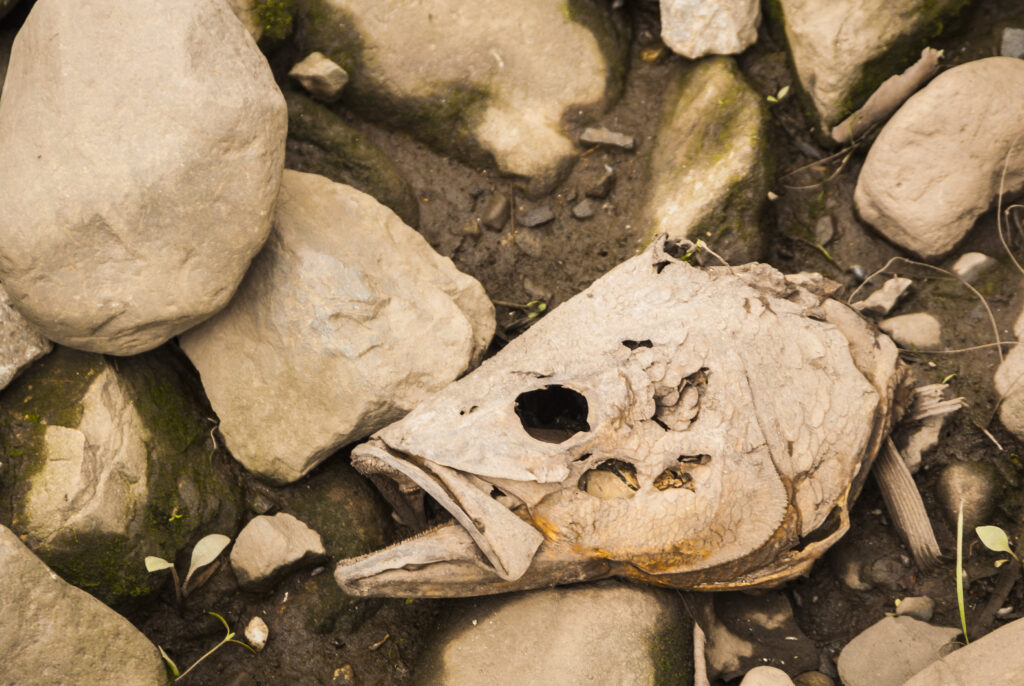
BILL SCHULTZ Do local fishermen complain about hypoxic events?? They do know about fish kills, but I don’t know if local fisherman are aware of hypoxic occurrences during the summer that occur in portions of the bay.
AUDIENCE Many of us do – especially when we see filth floating all over the place. Belmar NJ brings in ten 30-cubic-yard containers just to take the dead fish away. That costs the municipality money – and costs all of us money in the long run.
BILL SCHULTZ I know that occurs throughout the bay. Does it happen in other specific places?
AUDIENCE Yes, particularly dead-end areas where we get very concentrated pollution that uses up the oxygen.
ROB PIRANI Some fish kills are caused by chemicals. Last year or the year before, Shark River had a big fish kill in early spring – a time when everybody sprays their lawns with weedkiller and fertilizer. With a heavy rain event, all that ends up in the water.
AUDIENCE Three benefits of good human health, marine health, and health along the Bay Shore are swimming, fishing, and going to the boardwalk. Clean water brings people to the water.
BILL SCHULTZ To summarize the improvements you’d like, most of what you’ve mentioned falls under the category of guaranteed purity of the estuary’s water.
AUDIENCE Yes, people should stop fertilizing their lawns 4 times a year with huge bags of fertilizer.
BILL SCHULTZ Is the county taking that on? I know the State has done some work on it.
AUDIENCE Oceans in Action is trying to reconvene, because sections keep getting downgraded from lawn runoff – and, I’d guess, from septic systems as well.
AUDIENCE We just got a pump-out boat 4 or 5 years ago. But I suspect that all the pumping-out that we do represents less than one discharge from Perth Amboy. We can feel good about them both, but today’s water quality is still minimal.
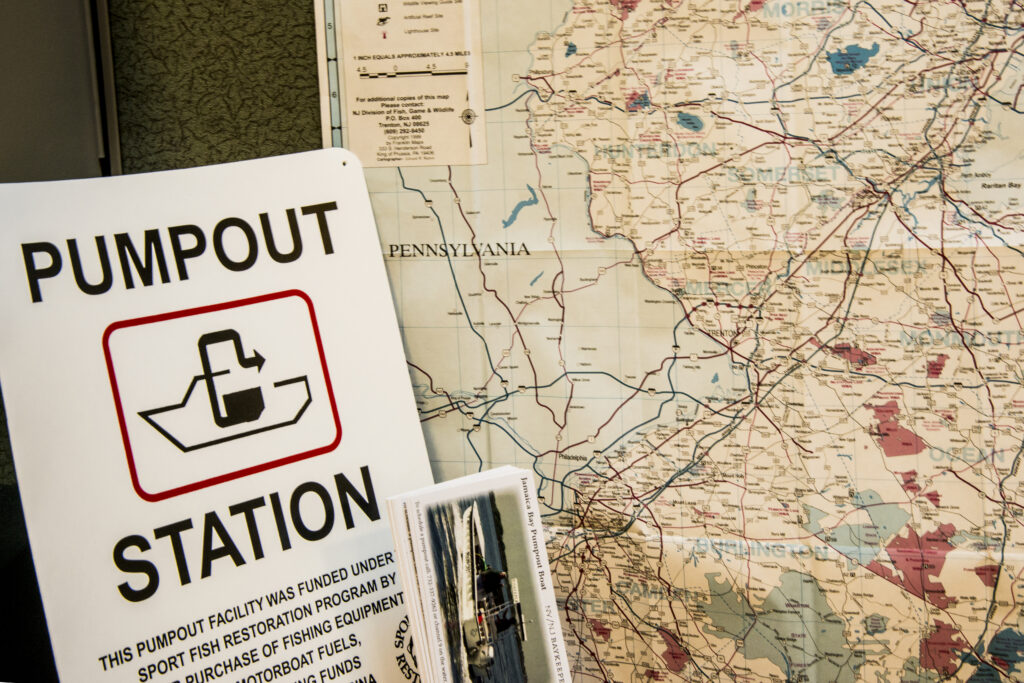
BILL SCHULTZ The big pollution contributions to Raritan Bay come down from the Arthur Kill and from Middlesex County discharges. A no-discharge zone for Raritan Bay is being actively discussed.
Q/C As I sail the East Coast from here to Maine, the worse place I ever see is right here.
AUDIENCE Do large concentrations of legacy pollution still just sit here? Should we dredge the Bay?
BILL SCHULTZ Other people here in the room probably know more than I do about specific places right along the bay shore. Two water sources that affect Raritan Bay seem to be the Passaic River and Newark Bay.
ROB PIRANI Actually to very little effect. Most of the Passaic River and Newark Bay flow goes out elsewhere. Only in extreme weather conditions does it come down the Arthur Kill. What we do have however is 20 Superfund Sites on the river or draining into the Raritan, and about 200 state-registered toxic sites on the Raritan.
AUDIENCE Do those sites drain into the Bay, or just sit in the river?
ROB PIRANI Some are just sitting there. Some are in the sediments. A couple of years ago, New Brunswick built a marina by dredging a short section of the river. That gave us a snapshot of what was in the sediment. Some areas had nasty toxins that are still flushing down from places like American Cyanamid in Bridgewater and other industries up that way. There are numerous sites like that.
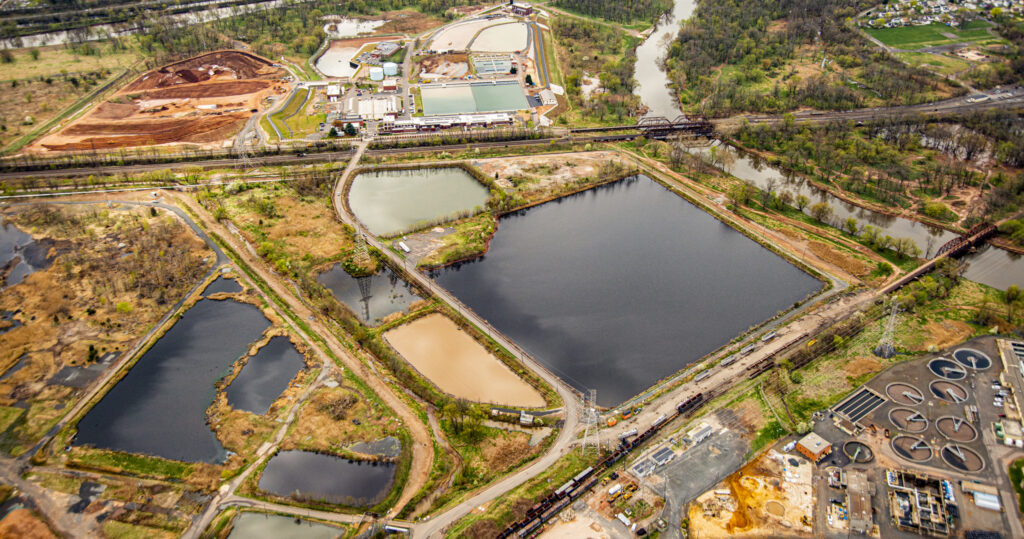
There is a big proposal for fortress walls and stuff. But there are no efforts to address river sediments. Their answer is, “Well, we can’t do that for months, because next to us is the Horseshoe Road Superfund Site. Next to that is another polluter supportive of Horseshoe Road….” There is a string of Superfund Sites across the river. There’s Edgeboro Landfill and ILR/Industrial Landholding Resources across the way, and more of the worst superfund sites in the country.
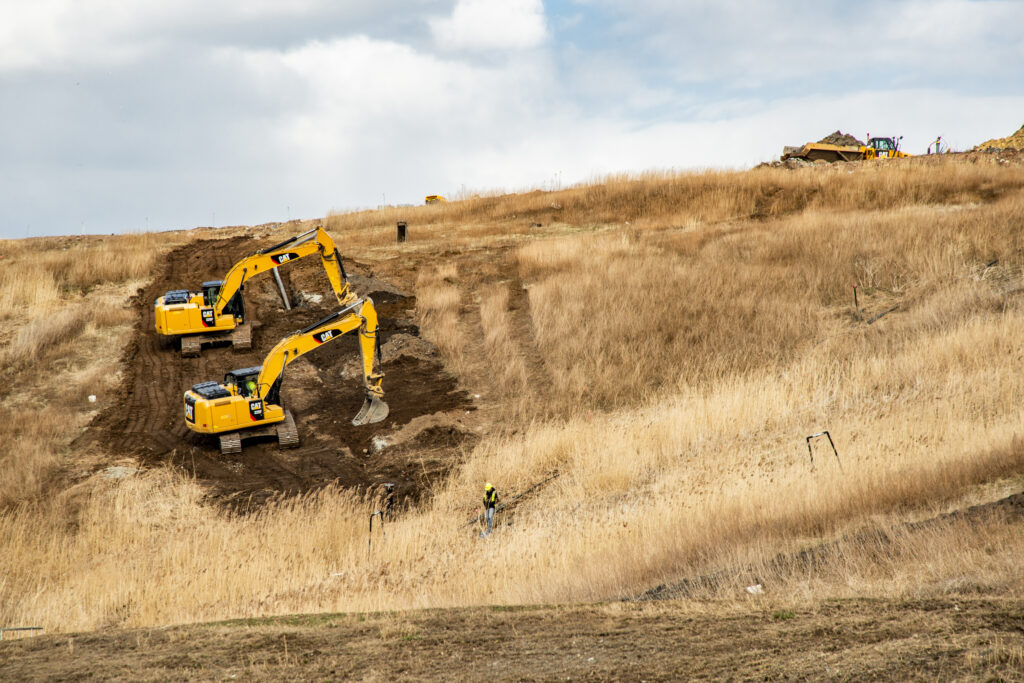
But with a case of beer, the Edison Municipal Dump, now capped but awaiting final closure, would let you dump anything you wanted. So, legacy-wise, there’s a lot of pollution out there. If you don’t disturb it, it’s okay. But when you start getting these strong Irene or Sandy weather events, they act just like a dredge.
AUDIENCE Each town should improve its stormwater drain management. That’s something that it seems we could do right now.
BILL SCHULTZ Are municipalities or local towns addressing stormwater management?
AUDIENCE We are increasing the number of rainwater gardens. But it always seems like you need a grant. Money issues stand in the way. It shouldn’t be the case.
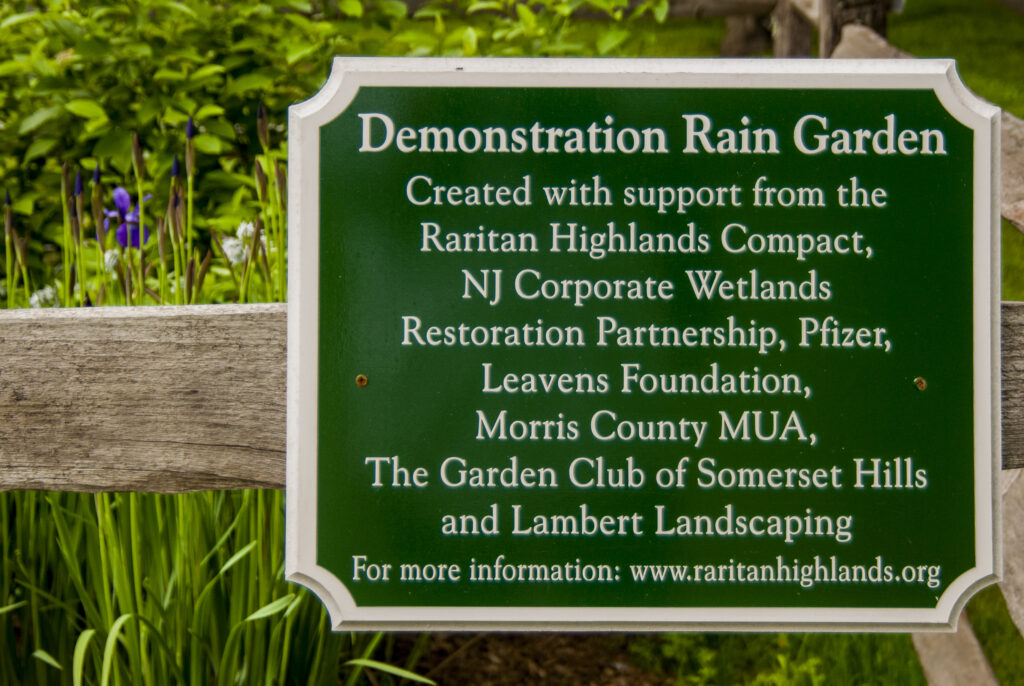
ROB PIRANI Another benefit for cleaner water means better fishing. In the past, Raritan Bay had quite a shell-fishing industry and many commercial fishermen. But today there is little left to harvest – whether blue crabs, hard clams, soft clams, and bay scallops. It would be good if we could bring those back.
AUDIENCE With all these Superfunds around the rivers, as the weather gets worse and we have more intense storms, pollution will get worse.
AUDIENCE I think we must look at what we’ve allowed to happen to the environment, and then make sure we don’t duplicate that. We must put up with what’s there – or do something about it. To be practical, there’s not too much that we can do with our infrastructure. But we can learn from history.
BILL SCHULTZ On a more nuts-and-bolts level, there are some actions relative to our toxic sites and their impacts on the Bay that we are looking at with an eye as to what we would like to see happen.
BILL SCHULTZ I’m interested to know whether your water-quality concerns are focused more on toxins or on fish contaminant levels?
ROB PIRANI Tomorrow is the 8th Rutgers Sustainable Raritan River Initiative. This symposium involves our breaking into groups for all kinds of discussions with very smart and very educated people and water people. Regarding the Lower Raritan River, the overwhelming revelation from this meeting has been that we don’t have any data.
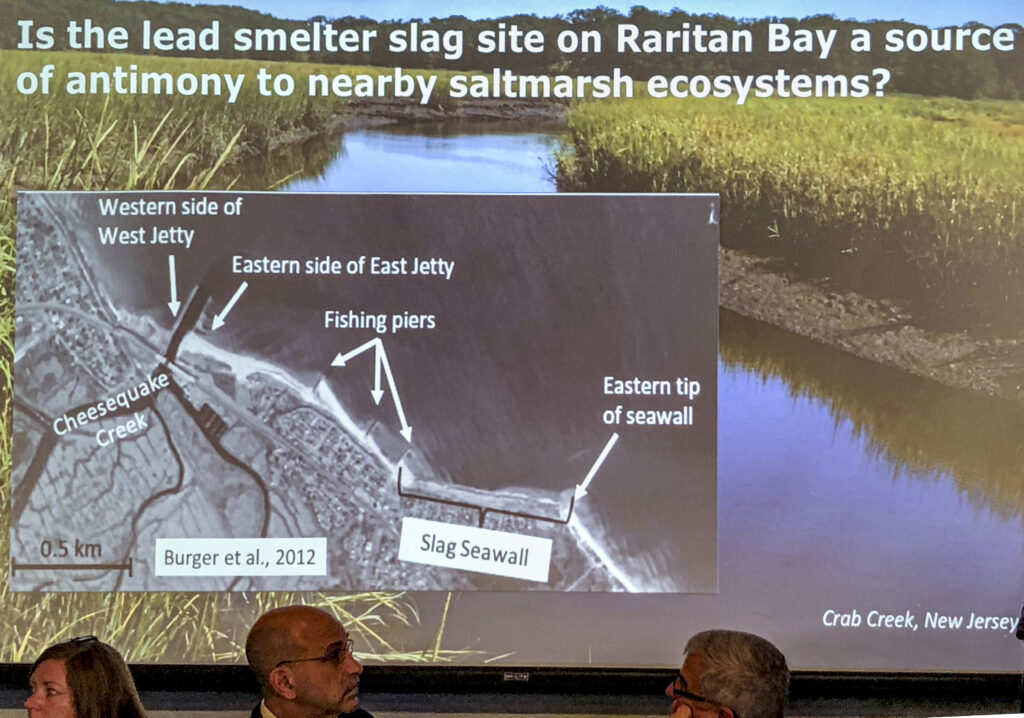
Above the confluence of the Millstone and Raritan Rivers, the water is harvested and sold as potable water. They can sell that water. It has a price value. However, from down there, the Raritan has been an industrial garbage can, and nobody cared. As we get scientists involved and interested, the first thing they say is, “Oh, sounds like you’ve got a problem. Show me the data and we’ll see if we can fix it.” Our answer has been, “We don’t have any data,” There’s been virtually no studies on the Lower Raritan, from where the water stops having monetary value to the ocean to Conaskonk Point clam waters (in Monmouth County). Now it’s gained value again from Conaskonk Point and in the Bay.
BILL SCHULTZ Yes, it’s an easily quantified value.
ROB PIRANI The State has decided the best use of the Bay is receiving discharge from MCUA, the Middlesex County Utility Authority. That discharge eliminates planning past Conaskonk Point, so the State says the best use of the Bay is to dump sewer water into it—excuse me, “treated effluent.” Flood monitoring gives us some real numbers so we can talk to people.
AUDIENCE I think you need more education on this. We must reach everybody, from kids in school and all the way up.
BILL SCHULTZ Education is one of our goals, so hold on to that thought.
BILL SCHULTZ Our second goal is habitat restoration. Yesterday we were talking about our Comprehensive Restoration Plan, which has identified 12 ecological characteristics of and established some goals for restoring its structure and function. Restoration sites throughout the harbor, and in Raritan Bay, have been identified and put on our website. Thus, you can see what’s happening in your neighborhood in terms of habitat restoration. There’s also information about our plans, what the project might be, how much it’ll cost, and who’s working on it.
We are making great progress, but we’re nowhere near our goals. We’ve done extensive wetlands restoration and created some tributary connections throughout the harbor, on the Raritan and on its tributaries.
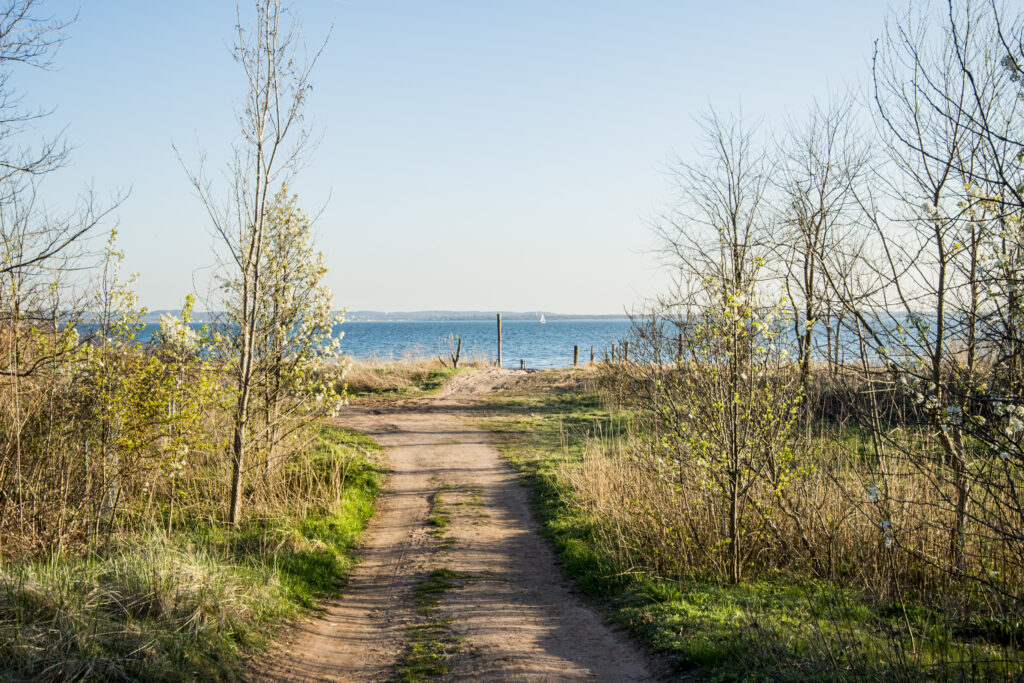
BILL SCHULTZ What specific benefits do you, the public, hope will come out of our Comprehensive Restoration Plan, its Restoration Workgroup and all the agencies that will work together on those projects? Specifically, would you like more attention paid to generic challenges or very specific places here along the Bay Shore?
AUDIENCE We need to protect the Bay Shore’s living shorelines, oyster reefs, water quality and habitats, especially with today’s sea level rise and increased storms. We saw what Sandy did.
ALISON M JONES (for NWNL) To follow-up on that comment, this week California had its primary elections. One of the issues in the 9 districts around San Francisco was a call to raise $500 million to protect San Francisco Bay from impending sea level rise – that will affect us all! The result was 69% of San Francisco voters voted in favor funding for this preventative action. What chance is there that that could happen to this estuary?
BILL SCHULTZ That’s a good question. San Francisco’s estuary program played a critical leadership role in helping make that happen. That’s certainly something that we are considering. As we do this Action Agenda, we’ll consider our wish list. That’s the easy part, compared to figuring out how to pay for our wish list, and who should pay for it. The idea of a voter initiative for restoration work is a great idea.
AUDIENCE How do San Franciscans support their estuary program, make voters aware of problems, and move them to vote by such a large majority?
ALISON M JONES (for NWNL) Good question. I live in Manhattan, not San Francisco; so I’m not sure. I just started following their initiative 2 weeks ago. Californians seem a little more environmentally active, especially since they face severe environmental issues now due to an intense drought drying up the San Joaquin River, which I’ve been documenting. As a result, they understand the impacts of lower flows entering the San Francisco Bay.
AUDIENCE That goes back to the education.
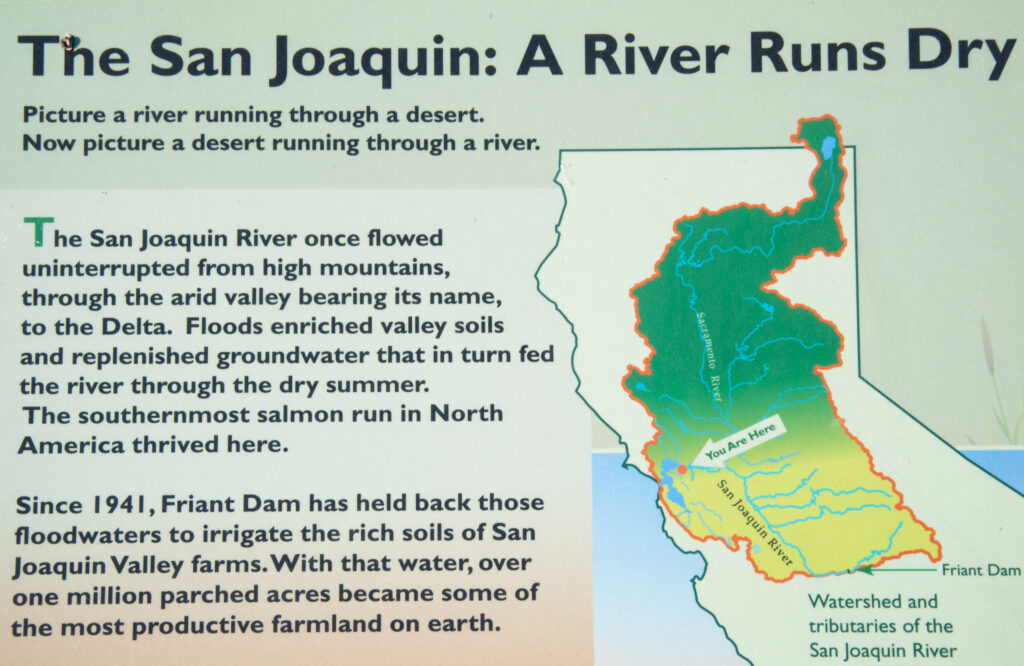
BILL SCHULTZ Does Monmouth County have a transfer tax on real estate for conservation work? Some Monmouth municipalities do, but I don’t know whether the County does. Municipalities all over New Jersey have voted for measures such as real-estate transfer taxes to buy parkland and to fund other conservation efforts. It’s an interesting question about whether voters here would be willing to do that for capital improvements for shoreline improvements.
ALISON M JONES (for NWNL) My understanding is that in San Francisco the $500 million will come from industries on the San Francisco Bay.
AUDIENCE That’s probably an “easier sell” than having funding coming out of voter’s pockets.
BILL SCHULTZ Back to habitat, ecological health benefits, and challenges: I think our challenge is how to pay for such efforts. Restoration of the 33 sites the Army Corps is focused on could cost $500 million. That’s not cheap – and not for the faint of heart.
AUDIENCE Regulatory hurdles are huge here; but we must remember the value of our water quality and the threat of not being able to use our Bay waters as a valued resource.
AUDIENCE It is time to end the difficulty in getting permits to do water-quality and shellfish restoration in these contaminated waters.
Q/C Today’s conditions are too unsafe. Historically, we had 350 square miles of oyster reefs in this area. That was 400 years ago. Then settlers started coming in. This was “the estuary of all estuaries” for oysters.
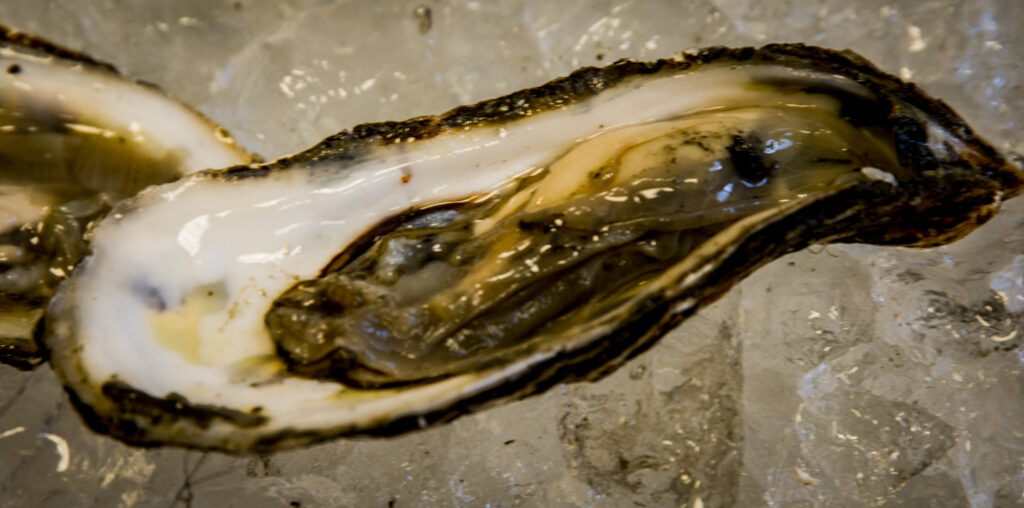
ROB PIRANI The challenges of funding are a huge challenge; but so is getting communities to buy into environmental restoration. For instance, we could restore a wetland or a shoreline habitat; but then Mayors and Planning Boards might put a multi-development complex right next to those areas – thus ruining our habitat restoration, or at least degrade it. So, we need a process to educate the Planning Board and Mayor and Town Council about what are we doing. Folks need to know why we are restoring this habitat, our long-term goals and benefits of restoring that habitat. We need to explain that our watershed improvements will still be valuable habitats 100 years from now.
BILL SCHULTZ And we need to write it in with other town planning work.
AUDIENCE Saving the three habitats that feed into the estuary and its stream ordinances would be very important and promoting respect for stream ordinances .
ROB PIRANI Regarding oyster reefs, over time the entire bottom has silted in so deeply, that any oyster reef gets covered with mud. I think siltation is fixable on a local level by preventing erosion and flashy stream runoff during intense storms. Rutgers is working on this with many communities. The habitat we’ve overlooked is the actual bay bottom.
AUDIENCE It’s bad. We have no oyster reefs.
AUDIENCE A lot of that is caused by our area’s impervious surfaces of streets, sidewalks, houses. In theory, the ground below these surfaces is “dead land.” The water doesn’t readily soak right into the ground there. Instead, it runs off. Rain is being channeled. With a heavy storm, ten times as much water goes into a stream than would be natural.
ROB PIRANI It’s all been engineered and so improving it on a local level is probably one of the most implementable changes that I’d like to see. There could be public education to explain the problem of paving more and more things. There could be incentives for more gravel parking lots or gravel driveway, rather than paved surfaces. Many places get paved for no real reason! The more porous alternatives would save money.
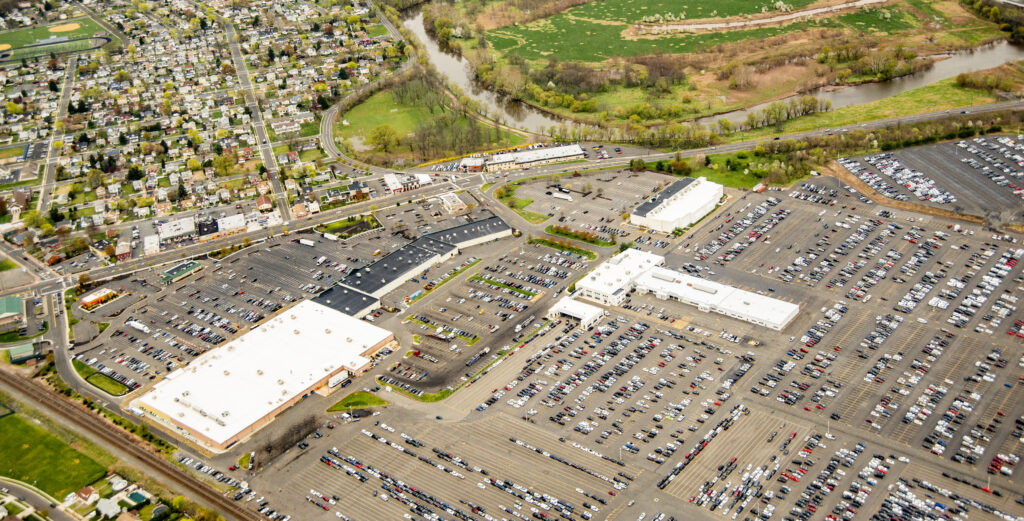
AUDIENCE How do you get the environmental commissions involved and get people to care? Tonight’s turnout is amazing. But how do we keep this going?
ROB PIRANI One thing is to get more involved with committees in your own town. You can help people become aware of environmental issues. You won’t always succeed, but you can stir interest if you sound like you know what you’re talking about. Go to hearings and make sure that planning that is discussed follows town laws. Without supervision and community input, instead of having X% impervious surfaces, you suddenly have 2 times X% impervious surfaces, because it seems no one cares. But you really can have an effect. You probably won’t be 100% successful in your efforts, but if you keep pounding on them, you can make a difference.
BILL SCHULTZ Have there been efforts in the county or along the bay shore to reduce impervious surfaces? I know Rutgers has an inventory in Monmouth County on impervious surface. Have any municipalities along the Bay Shore done a significant job in reducing impervious surface or ordinances?
AUDIENCE Keyport is part of Sustainable New Jersey.
AUDIENCE I’ve been on a Planning Board, a Green Team and Environmental Commissions. There are some challenges with Planning Boards. Applicants come before Planning Boards with professional help to pitch support for their plans. Our Master Plan is outdated and should be updated – and, like every Master Plan, it should have a Natural Resource Inventory. Ours, importantly, is prepared by professionals. I think it’s incumbent upon the Environment Commission, the Green Team, and the Town to make sure their Master Plan is up to date. When applicants come before the Planning Board, it’s very, very difficult for the public to challenge their plans or actions. Most cases are very large projects and very difficult to oppose.
ROB PIRANI Sometimes we lack the needed expertise when applicants come in with experts. We have little towns with volunteers on our commissions who often lack the expertise to look at an estuary plan. That’s where we need the help.
AUDIENCE There’s a lot of misinformation on committee regulations. We hear: “Well, you can’t be on the Environmental Commission, and also be on the Planning Board, at the same time.” That isn’t true. My impression is that people on the Planning Board are very often local people who lack experience.
BILL SCHULTZ Sustainable Jersey, ANJEC or other such groups can help in that situation, especially regarding estuary-specific issues.
AUDIENCE ANJEC is very good in providing us with information and guidance, but we need help in finding professional support.
AUDIENCE We had a developer propose a very large project on about 60 acres of farmland (or paved soccer fields, parking lots, and all kinds of other goodies). Enough people got so angry that they were successful in getting the developer to leave. The property was very close to a stream, in addition to other problems; but I don’t think the opposition was motivated by concern about the stream. It was motivated more by potential increases in traffic, noise, lights and other issues. But it showed that when enough people become involved, Planning Boards start backing down.
AUDIENCE Planning Board members follow the lead of their attorney on the Board. It’s also important to have a strong Master Plan with a Natural Resource Inventory and a strong Stormwater Management Ordinance, as we have in Keyport. The Saltwater Management Ordinance needs to be approved locally and put on the books.
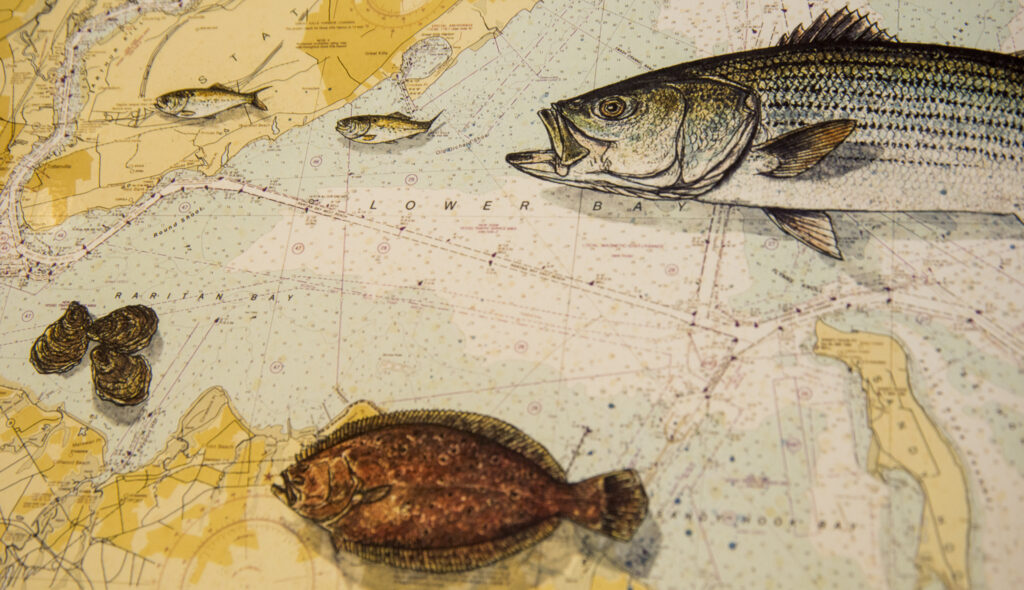
BILL SCHULTZ Public access is one of the most direct benefits that people enjoy. We recently inventoried public waterfront access around the estuary. That’s good, compared to many other estuaries, including San Francisco Bay. We have a fair amount of public parkland and public easements on private land, enabling public access to the shoreline. People can’t always enter the water, but at least they can enjoy being on the waterfront.
Yet even that access is not evenly distributed, relative to concentrations of communities lacking outdoor opportunities. Some places around the harbor need access more than others, often because town budgets are tight. They might lack management capacity to provide service maintenance for public parks.
How would you like to be able to use the water and the waterfront? And what are the key access challenges and the favorite places along the bay shore?

AUDIENCE I’d like to fish and to harvest other wild foods without being afraid for my health.
AUDIENCE Swimming seems such far-fetched option.
BILL SCHULTZ Could there be more beaches along the bay shore?
At Atlantic Highlands a couple of weeks ago, people talked about a park used by the public; but there was no swimming there because there was no money for lifeguards.
AUDIENCE At Union Beach, people swim off that main beach on Union Avenue. In summer, they sit at our beach park. I see people going in the water. I’ve swam in that water.
AUDIENCE We’re testing pathogens testing all along this bay shore, to know more and to share it publicly.
AUDIENCE Swimming beaches in this area exhibit great variability. We have beaches with a sign saying, “Unprotected beach, swim at your own risk.” Along Cheesequake Creek’s Morgan section, there are no signs, as the Township decided to ignore it. In Old Bridge Township, the past administration erected a police substation on a beach with personal watercraft, jet skis, a boat with an outboard motorboat, and 2or 3 ATVs they’d use to patrol the beach. Then after an election, budget cuts, they sold all the equipment, closed the substation and turned their back on the beach. Now the Township apparently just doesn’t care. There are no signs and nobody there to stop you from using the beach. On a summer afternoon there are hundreds of people on that beach and swimming. Meanwhile, Perth Amboy has an ordinance against swimming by ordinance and the threat of a $500 fine.
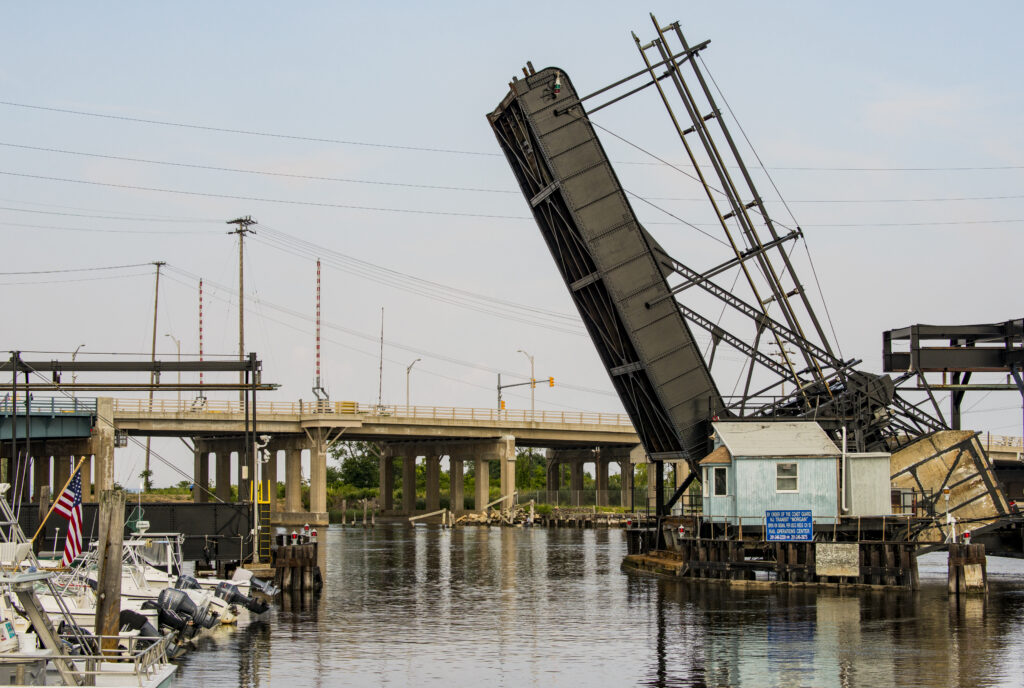
So the difference between the water at Perth Amboy to Keyport to Old Bridge varies vis a vis municipal ordinances against swimming. One town ignores the beachfront and doesn’t care if people swim or not. In a town like Keyport, they warn that the beach is unprotected and that swimming is at your own risk.
AUDIENCE None of these beaches are tested, though, because they’re not bathing beaches.
AUDIENCE The State doesn’t want to test the bathing beaches, because if they determine water is dirty, then it’s a “beach closure” – and you know what that does to tourism. The State doesn’t want open that can of worms. But at a recent discussion at Rutgers, some of the kids discussed a survey they were starting. I said, “Don’t look at just what are the people doing, but also their perceptions. I’ve seen mothers grabs their kids, saying, “My kid will never touch that water.” Those Rutgers students and we must ask: “Why? What do you know about that water?
We have perceptions passed from generation to generation. Ask what the perceptions out there are, regarding the water. What do people think is the water quality? Is there a basis for it?
AUDIENCE I have an option that’s not very expensive. If the State won’t test the water, why can’t a local organization test the water, and then post it to the web, Asbury Park Press, Star Ledger and New York Times. Probably the Times’ weather page would list beaches’ water quality listed. If numbers are bad, that will raise a ruckus.
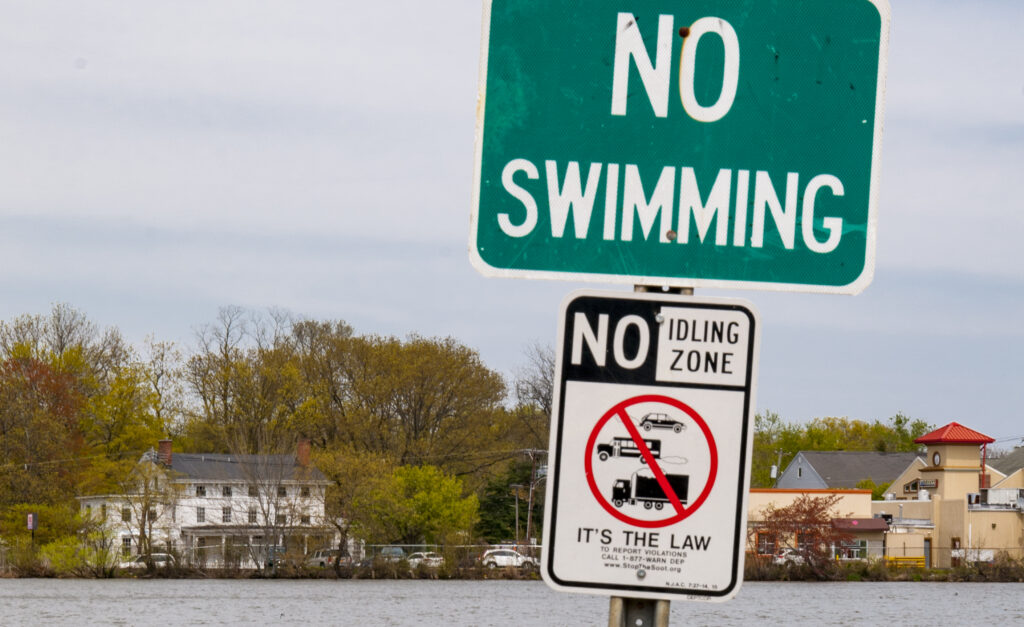
BILL SCHULTZ HEP has given a grant to the BayKeeper-Bay Shore-Lower Raritan Partnership to do just that. So, we’ll go out every week starting Monday – and after rain events – to collect data through this grant, run tests and release it weekly. Now we’ll be able to tell people whether the State will accept it, even though it’ll be done by using EPA standards. I hope we don’t find anything, but if we do, we’re able to really make people mad.
AUDIENCE I’m afraid to go in the water. I don’t know whether it’s safe; but it looks gross – with too much floating algae and “grunge.”
BILL SCHULTZ What should be our next step? A public survey to better understand those perceptions? Or should we figure out management solutions to allow people the chance to swim here safely? Obviously, if when it’s hot, people will go in the water, no matter what.
AUDIENCE What would the result of water-quality testing be? I’m very curious about testing and the publication of those test results.
BILL SCHULTZ We’d put results on our website. It will be out there.
ROB PIRANI That’s the key part. I’m from Oceanport. Our water-watch community tests for pathogens and CFUs, but only a small number of people on our Environment Committee know the results. Those water-testing results need to be shared across municipalities. We all share the same water, but each county does its own management.
AUDIENCE I hope those results offer something we could build on and fund. The State isn’t yet doing it. Until they do, we need to publicize those results.
ALISON M JONES (for NWNL) Yes. And that will raise voter awareness to get the kind of voter momentum that San Francisco has established to protect the quality of its Bay waters.
BILL SCHULTZ That’s true. And the Hudson Riverkeeper has a well-established water-testing program. They have a great website. You can click on a dot, for information you’re seeking.
AUDIENCE Do you publish that data just on your website or is it also on your Twitter account?
BILL SCHULTZ Because our testing is a contract with EPA, our report will ultimately go to EPA. Conditionally, we’ll put it on our website, Twitter, Facebook and such…. But we can’t publish it until it’s gone through the Quality Assurance Program. Once that happens, results will be on our website with a Google Map that you can click on to see water-quality results.
AUDIENCE My only concern is that the results be presented in a way that people would understand what they mean. You can’t just list so many parts per million of this or that. That means nothing to me. Your results should either say, “Don’t swim” or “Do swim.”
BILL SCHULTZ We’re basically looking at “Go /Don’t Go,” or “Red/Yellow/Green.” But there’s also a little bit of gray area. My understanding is the bathing-beach standard is 3% – since you have only a 3% chance of getting sick. If it’s more than 3%, we‘d close the beach. If it’s less than 3%, you’re good to go. That is based on epidemiological studies.
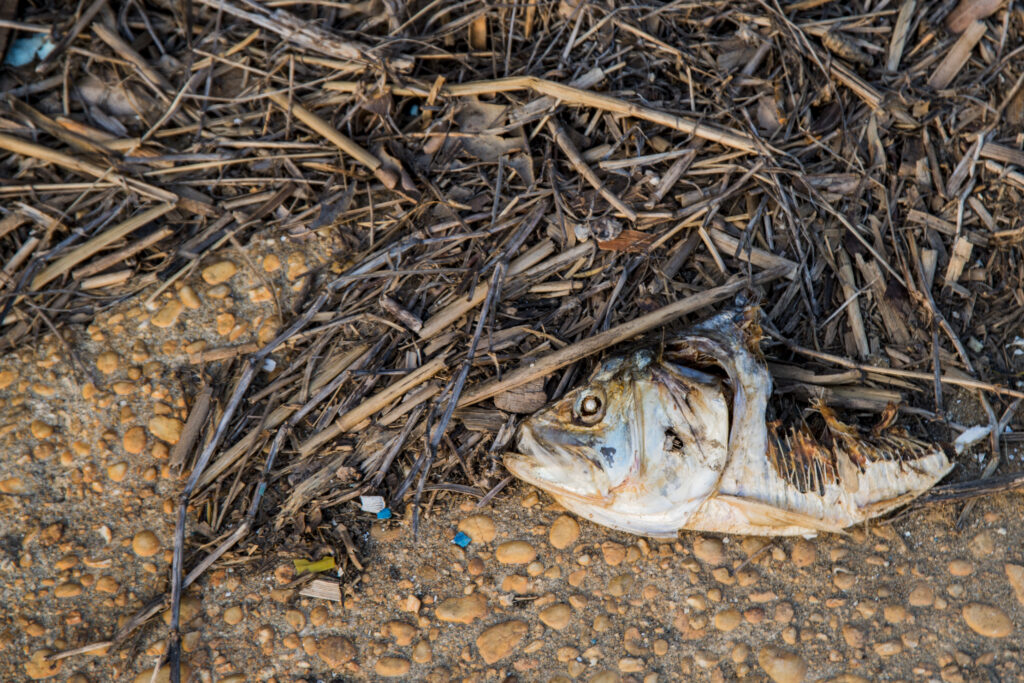
ROB PIRANI Water quality is getting better. When I was a kid, there were piles of garbage floating in the water. We used to call them “sea monsters.” We still have a long way to go. We must educate people who want to swim, just like we educate kids to look both ways to cross the road. We must also educate people that they shouldn’t be in the water after it rains, after a storm. Every water-testing event I’ve seen 24 or 48 hours after rains shows that water quality usually spikes up very high. It is full of garbage because we do such poor watershed management in this area. This junk and garbage come from Holmdel down through Middletown and Marlboro into the Raritan Bay and Sandy Hook Bay. It stays there for a couple of days until it gets flushed out.
BILL SCHULTZ Not only that… Regarding public access and water quality, I think we need to celebrate the success that’s going on. Why doesn’t every town have a “Water Day”? Why doesn’t every town do something to get people out on the water?
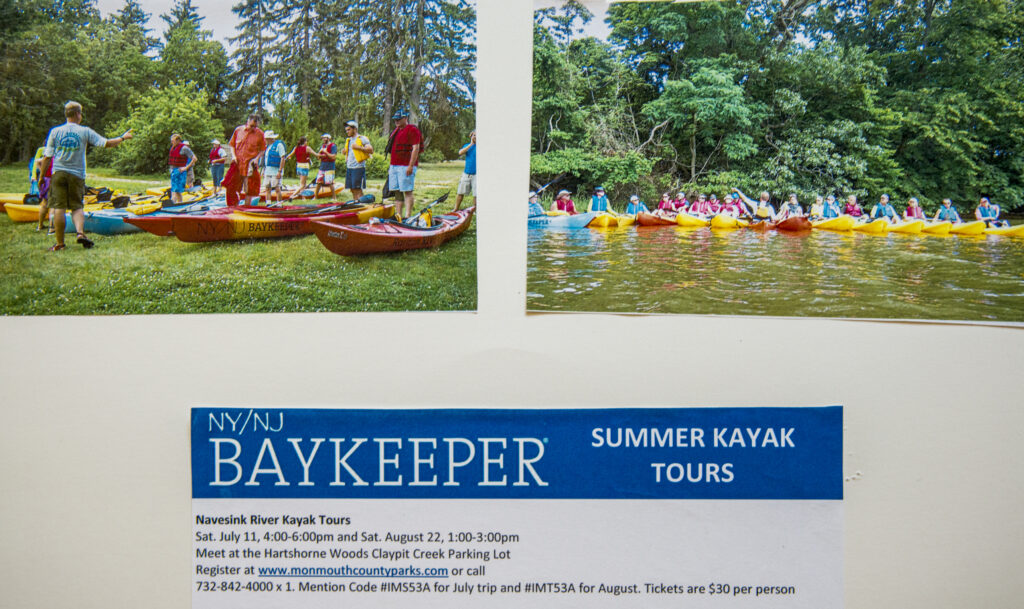
We should support kayaks, boats, swimming and other activities that get people back onto the water. They do a great job on the Hudson River to get people out on the water. But here, we do a poor job. We need to get people back onto the water and celebrate our success. Then when people see what still needs to be done, they’re more apt to buy in and help. When you enter the Chesapeake Bay, there’s a big sign that says, “Welcome to the Chesapeake Bay Watershed area.” Here, there’s nothing that says, “Welcome to the Harbor Estuary. Welcome to Raritan Bay. Welcome to Sandy Hook Bay. Welcome to the Lower New York Bay.” How about: “This is our harbor. Welcome to it, and let’s clean it up!”
AUDIENCE There are small signs around here that give the name of the creek and then put it in a bigger frame, by saying, “This creek is part of the Harbor Estuary.”
BILL SCHULTZ That needs to happen – on a bigger scale.
AUDIENCE Going back to what Bill said on why people shouldn’t go in the water…. Last year, big red signs were put all around here by the EPA saying, “Condemned.” They were about shellfish, and people freaked out when these signs appeared.
AUDIENCE We were told that EPA didn’t do it, but that it was an angry citizen.
BILL SCHULTZ One of the goals for the Harbor Estuary is recognition that the Port isn’t part of the Harbor. It’s the largest port on the east coast, and obviously a major economic driver for New Jersey and New York.
A major Harbor Estuary Program [HEP] management issue and challenge involve sediment management, toxic sediment, the movement of sediment and those impacts. These sediment issues affect fish and people’s perception of water quality. So HEP’s responsibility is not just the management of navigation channels and the cost of dredging. Many marinas on the Bay Shore have their own challenges, including ports, navigation channels and maritime activities, They’re all a priority for us.
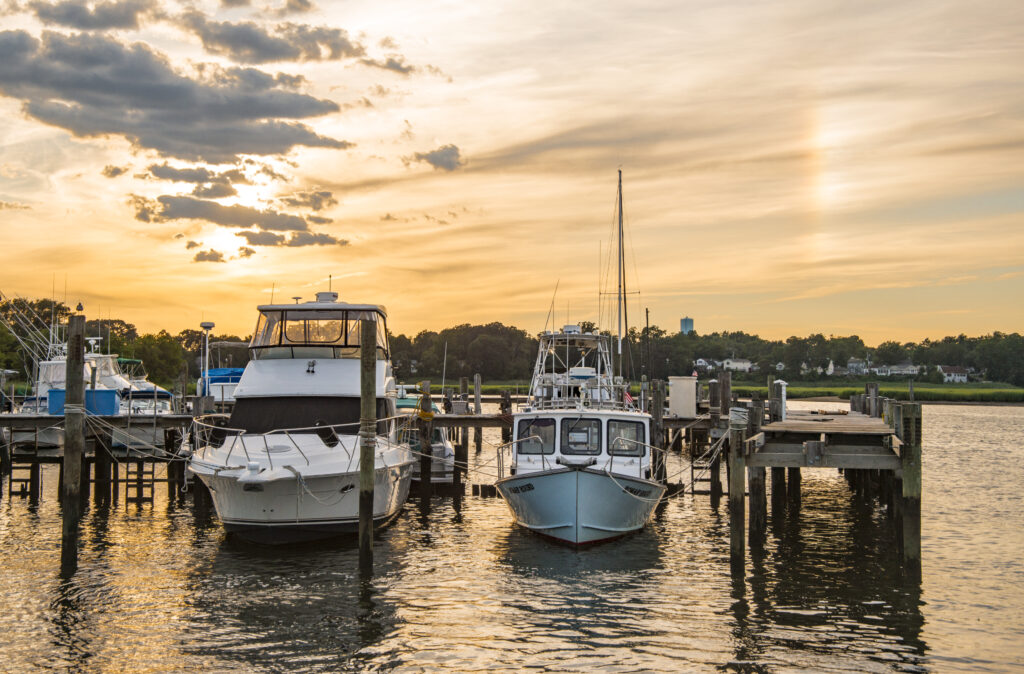
AUDIENCE I think it’s important to maintain the boatyards that people use. Otherwise, we’re going to lose them to developers. All those slips and places where people put their boats in the wintertime could be gone.
BILL SCHULTZ Yes, they are getting outpriced by housing.
AUDIENCE We need to concentrate on our waterfront’s importance to water-dependent uses. The sidebar to that is the fact that we now have cleaner water, more fishing, prettier vistas…. So instead of driving to the waterfront or sitting in a park, people now want to see these views from their living room. The residential pressure on all our marinas and water-dependent uses is tremendous. We’re losing marinas every day, and almost all of them are being replaced by residential buildings. Look at how things are going. Factories put up here today can file for bankruptcy and go away in a year or two. That land then becomes residential and blocks the views so we can’t see the water.
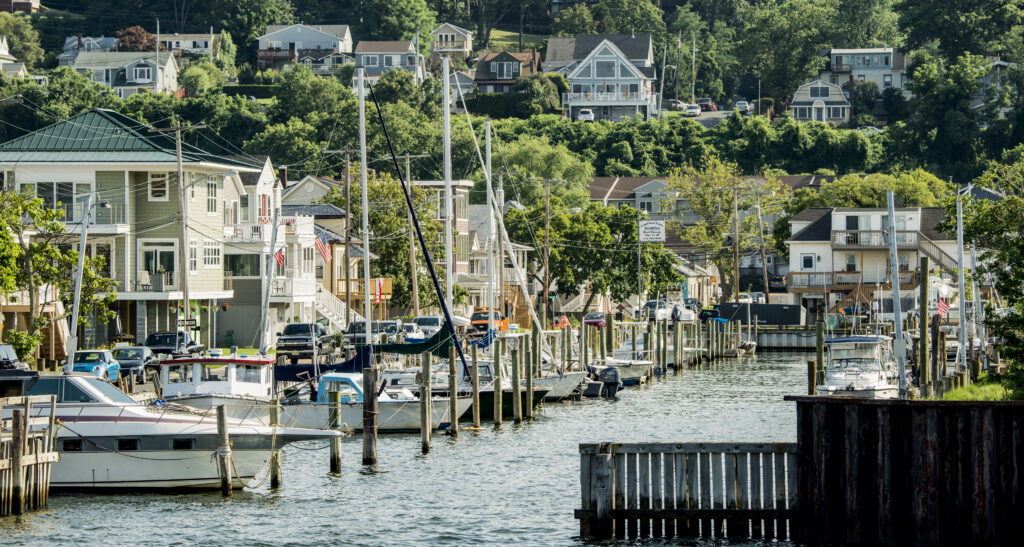
BILL SCHULTZ Have any of the municipalities looked at maritime zoning?
AUDIENCE No. Municipalities are coercing the residential boom because they want the tax rateables to boost their coffers. Who wants a boatyard when they can put up a ten-story high-rise and bring in millions of dollars in taxes. Don’t look to the municipalities for help.
AUDIENCE I think what we need is something like farmland preservation.
BILL SCHULTZ That could include buying easements and giving the boatyards some capital. I know municipalities in Massachusetts have done some of those programs – as well as Portland, Maine.
AUDIENCE A few comments about the boating situation. I’m pretty sure that the biggest marina around here is Atlantic Highlands, with a long wait to get in there. There’s more demand than there is space. Plus, every time there’s a Nor’easter, boats get washed up against the rocks. The Bay is not set up in a way that encourages boating, or that provides available marinas and safe harbors. If you have boaters, they will support our demands that the water must get cleaner. But if you make it unfriendly for boating, then they’ll go, and no one will say a word.
Long Island Sound and Keyport have stone jetties to keep boats from getting smashed every time there’s a storm. We don’t have anything like that around here, except in the Atlantic Highlands, but when the wind is out of the east, boats get knocked out.
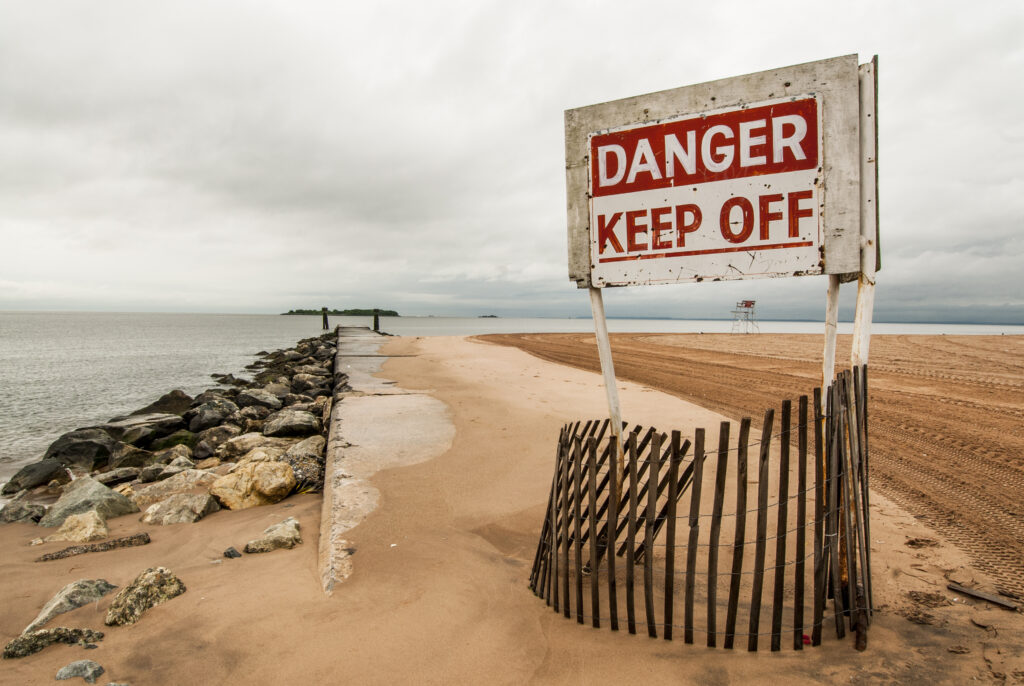
BILL SCHULTZ Are there any other maritime questions?
AUDIENCE The ferries are an important transportation aspect. The cost now to go to New York on the train is quite expensive. Keyport tried to have a ferry; but they only had one boat operating, so it just didn’t work out. If we could take people to New York more efficiently over the water, it’d be great. Maybe it could reduce the number of cars, so we could reduce the amount of pollution.
Yet the impervious surface problem with all the parking needed for ferries, would mean a big parking lot down there.
AUDIENCE There are different kinds of paving techniques – and impervious surface could be used.
AUDIENCE There is also impervious concrete, and then there are pavers with proper underlay.
AUDIENCE Some green projects put big water tanks under parking lots to collect rainwater: but, again, where’s the money?
AUDIENCE There’s still the rumor that South Amboy is talking about ferry service coming back.
ROB PIRANI Well, they had ferry service, using the generating station’s parking lot. They’re talking about revitalizing the project and continuing that road on into the old generating station.
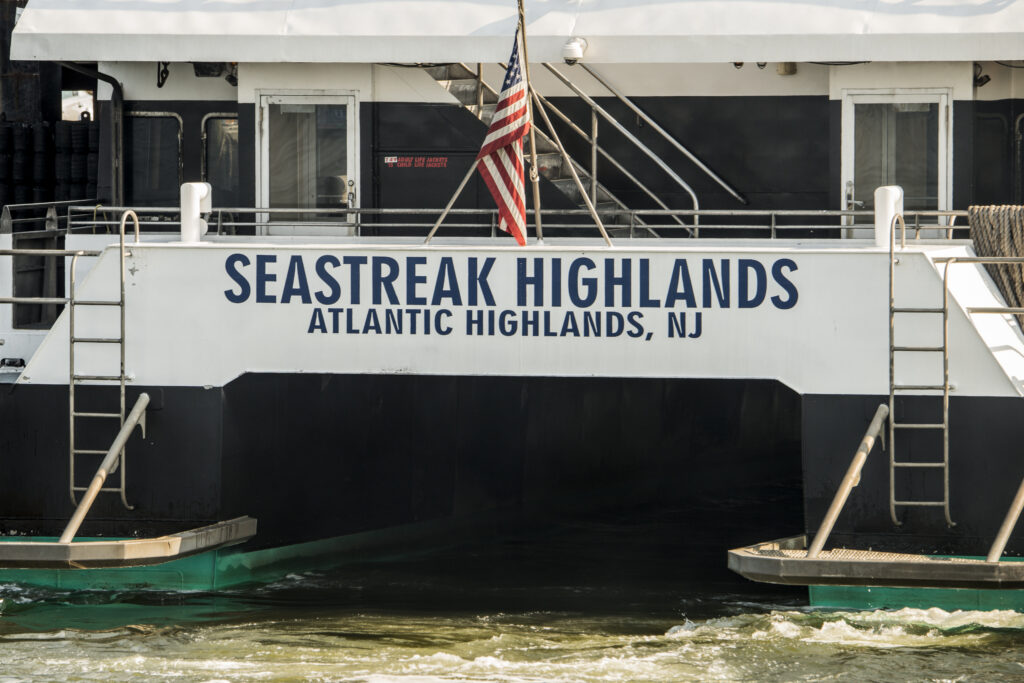
BILL SCHULTZ Tonight we’ve repeatedly touched on public education, because obviously it cuts across many aspects of our work. We have no data on this, but anecdotally it seems people are more and more enjoying the Estuary and Raritan Bay. We see more boating activity, but we haven’t quantified it. Certainly, there are more public parks and ways for people to get to the water. They’re not necessarily in the water, but they’re next to the water.
AUDIENCE They’re not fully utilizing potential water activities here. In Manhattan there are free kayak services and other activities like that. Last time I was there, there were about 23 boathouses on Manhattan’s Hudson River.
AUDIENCE I want to go kayaking this afternoon. Where can I borrow a kayak and a paddle?
AUDIENCE Keyport.
AUDIENCE Pretty limited.
BILL SCHULTZ Yes, there needs to be more.
AUDIENCE Where else can I go? Perth Amboy has a limited Summer Program. They started with a couple of kayaks that somebody gave the town. Every year they doubled the number of boats, because everybody wants to come down and go paddle.
ROB PIRANI I agree that there should be more opportunities for free kayaking and paddling – absolutely! We’re wasting a great opportunity. The best way to enjoy the harbor is if you have a boat; but so few people have a boat. We need to find ways to get people more on the water.
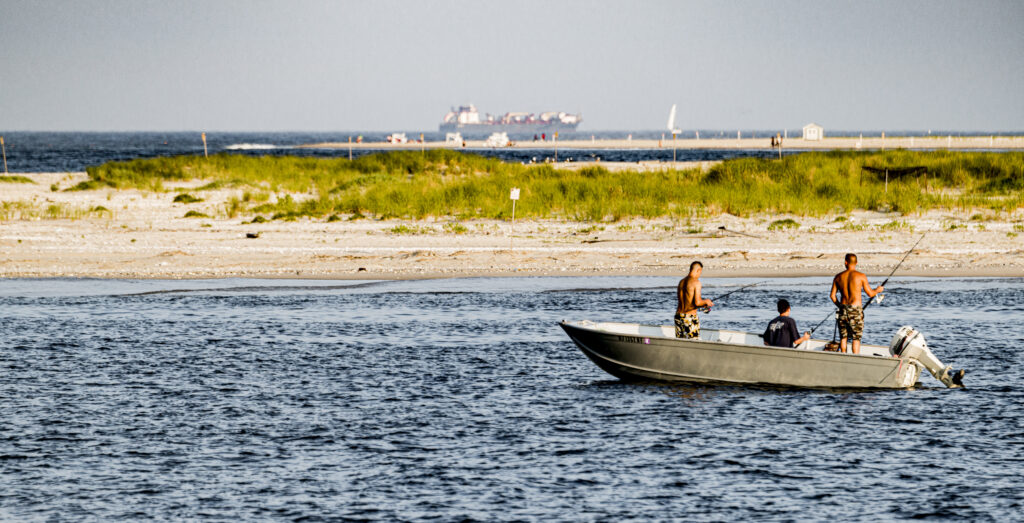
BILL SCHULTZ Let’s connect the dots a little bit from the way we think about public access to the way folks can be more actively involved in stewardship and decision-making. That’s always been our goal. It’s great to get people aware of these waters, but we need a bigger Mission! A kayak is a great way to get somebody interested in water-quality issues in Citizen Science. We have documented the growing number of civic groups like the Bay Shore Council, Baykeeper and the Raritan Riverkeeper. They are out there working around the harbor.
A voluntary survey tallied about 150 groups, but there are probably between 200 to 400 groups working out there. Collectively, they touch a fair amount of people, through membership and their volunteers. As we think about public education, our priorities should be in a framework of how to get more people aware of the Harbor, the Estuary and the Raritan Bay. We want them to become more engaged in decision-making and stewardship. One avenue is via these civic groups already on the ground doing the actual work.
AUDIENCE I’d like to bring up Joe Reynolds’ earlier point about signs. We travel over bridges every single day. Every little creek has a bridge or a culvert, and every single bridge has a name. But people just don’t know that. Probably 15 years ago, the Bay Shore Group put signs at these creeks, so the kids or the folks driving over that bridge say, “Oh, that’s Whale Creek.”
If we could encourage every township to do that, the logo exists. The signs are great. If you have them, suddenly people will become more aware – and then more involved. Even just driving over a small bridge would raise the consciousness of the watershed.
AUDIENCE I agree. It’s such a small thing, but I love the idea of it. It just connects us to our water source and makes people remember where we live. That then brings a level of respect to our watershed. Otherwise, people forget where we are.
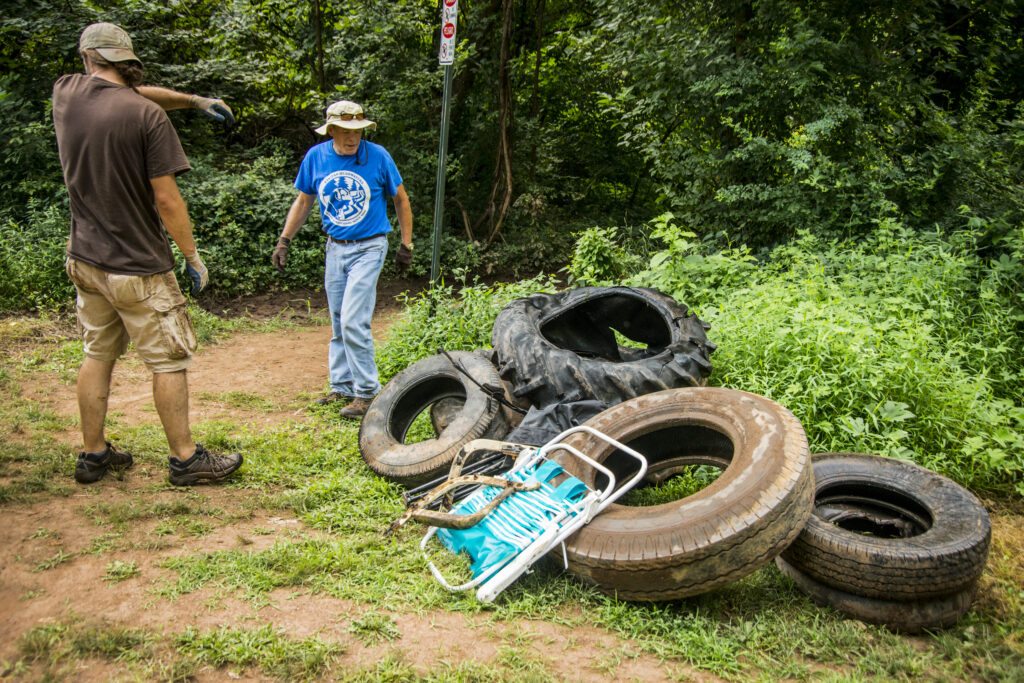
AUDIENCE While working on a Green Brook. Cleanup, I got into a discussion with a guy. I said, “Hey, I was riding through this neighborhood, saw this big stream down here. What stream is that?” Three people give me three different answers: “Wait a minute, don’t you live here? I’m from the other end of the watershed. You live here. I think that’s Middlebrook….” Then somebody came up with another name. Then somebody said Smith’s Brook. If the people that live on that stream don’t even know its name, how do they take ownership or focus on its water quality? How do they say, “We need to be concerned about it,” if they don’t even know the stream’s name. Signage could be a greatly motivating tool.
ROB PIRANI Yes, there needs to be more hands-on activities for people of all ages. So we’ve talked about restoration, getting people involved in cleanups, more hands-on activities, more programs and craft projects that get people to want to clean up this estuary.
BILL SCHULTZ Is that involvement just a question of money? Obviously, money is not unimportant, but is there something besides money that would help?
AUDIENCE Being able to do specific projects is critical, whether restoring the wetland, or cleaning up the creek, or working on this water-testing project. Getting local volunteers involved makes a project much richer – such as when people and go out there and test the waters themselves. Then they can tell friends and family which gets people talking and asking, “What’s going on over there?” When we get more people involved in hands-on activities, we start a conversation, and then that’s a good thing.
ROB PIRANI We are realizing how many people care. I’m overwhelmed with how many people came to our trainings, often 35 people. People are aware; they care; and they’re mad. That is good to see.
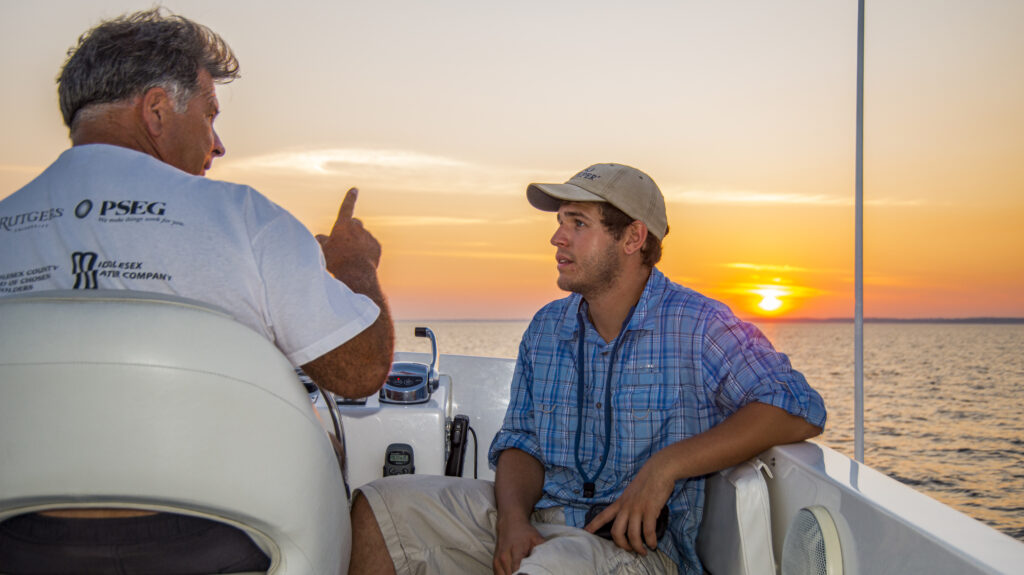
BILL SCHULTZ Obviously, more money and more programs help. But besides more money, is there something that either would help our programs be more successful or help us more efficiently get the word out?
ROB PIRANI We need more towns to get involved! Keyport does a great job, but we need more towns like Keyport. Keyport’s one town, and thus they’re just limited to what they can do. Middletown’s one of the largest townships in New Jersey – yet I don’t see them doing a whole lot.
I think we need to have our elected officials schooled about the estuary and its issues they should understand. Maybe we have a public responsibility that when somebody runs for office, we ask that person, “How do you stand on our watershed issues?” or “What’s your opinion about our water quality?” If they’re asked enough times, and those questions are brought up frequently in our towns, maybe something will be done. The same holds true for those attending meetings of their Planning Boards and Environmental Commissions.
BILL SCHULTZ You want to talk about education? You want advocates? Give me a way to get somebody out on a boat. Let me get somebody out on a river or out on a bay — and I’ve got an advocate for that body of water, because they can’t help but fall in love.
You want education? Educate the politicians who go to City Hall. Just say, “Geez, you know, we’ve got to do something with the beach.” They’ll ask, “Why?” Suddenly, you’ve got a politician listening. So, then you say, “We’ve got to do water-quality-testing,” and explain the pollution threats that face swimmers. Let’s educate the politicians.
AUDIENCE Maybe we should take all the politicians out on a boat?
AUDIENCE I keep coming back to Joe Reynolds saying we should re-think the concept of an estuary. To me, one of the biggest problems is the charm of New Jersey’s little towns, because we don’t tend to think of the estuary as a shared “whole.” We think of it as belonging to Keyport and Union Beach and Belford. There’s just no working together or planning together. We’re all focused on our own tiny towns of 7,500 or so people. We don’t cooperate with each other.
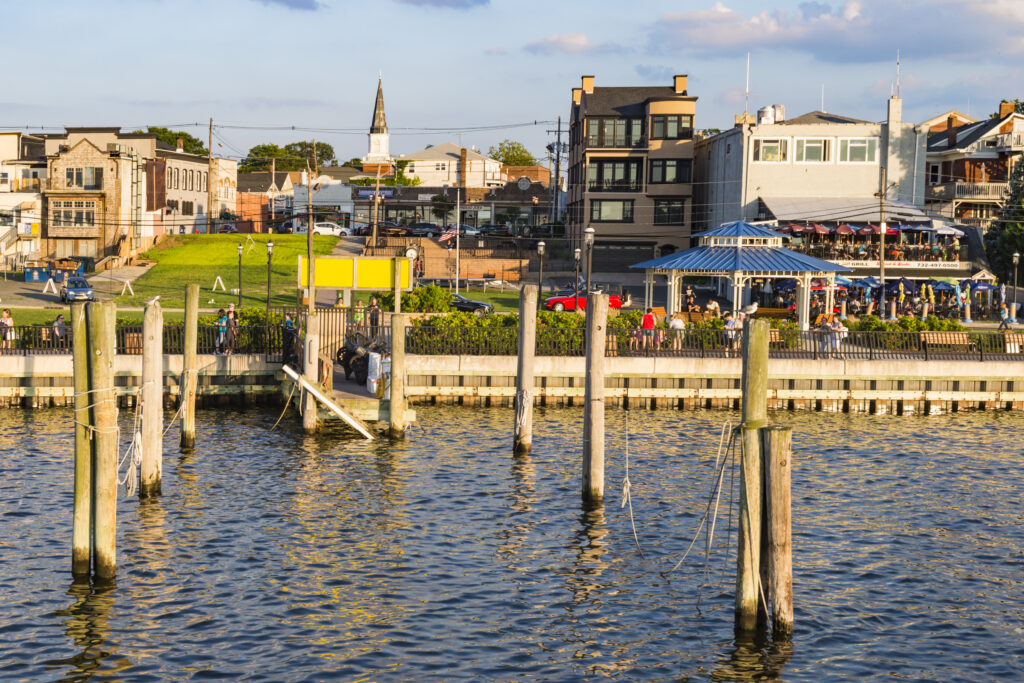
BILL SCHULTZ Does the Bay Shore Mayor’s Council still exist? I think it’s now defunct.
AUDIENCE Are there workshops on ways for people on Environmental Commissions to get some shared training?
BILL SCHULTZ That’s a great idea. There is ANJEC, the Association of New Jersey Environmental Commissions. It was created to be a support group for our Environmental Commissions. I don’t know how active they are in this area, but certainly that’s one resource. Sustainable Jersey also works with our Environmental Commissions.
AUDIENCE In terms of educating those people who are making the decisions, you can invite them to something like this evening’s meeting, but they’re not likely to come. However, you could show up at meetings od ANJEC, New Jersey municipalities, training organization, etc. to offer to present your findings – as well as for school students and the various Boards of Ed. If you put memos in the in-boxes of science teachers, they’d be willing to have you do a classroom presentation. Keep thinking along those lines….
BILL SCHULTZ Those are good points. Thank you all for your input.
At the conclusion of these public meetings, we will draft a report, and post it on our website. If you give us your email address, you’ll be notified when it’s online. You’ll get a chance to respond, and we’ll work with some of the folks here from the Citizen’s Advisory Committee, including Joe Reynolds and Meredith Comi, to make sure it gets out to you folks who are participating in this process.
ALISON M JONES (for NWNL) Tonight, someone mentioned the word “celebrate,” I’m from Manhattan, but I’m here tonight, because Bill took me out on his boat last summer. I’m here as a conservation photographer documenting the Raritan River Basin – along with 5 others in N. America and Africa. At a Rutgers meeting on the Raritan, Bill talked about the whales and the dolphins entering the Bay. I asked him, “Really? Can I go out on your boat?” I’m an example that the more you talk about the Bay, the more people will celebrate it.
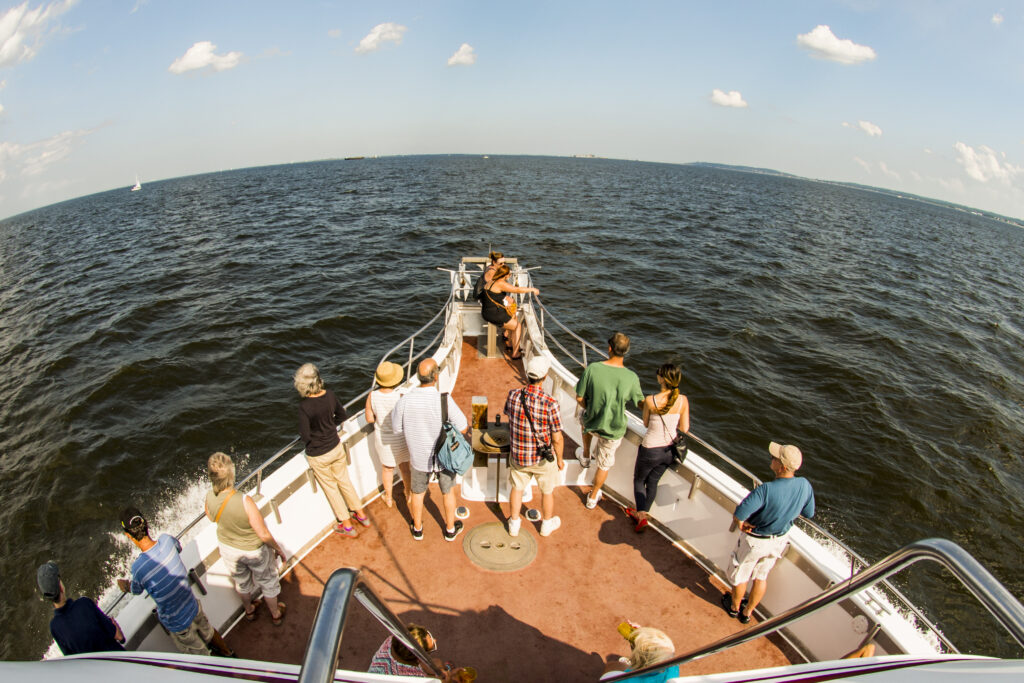
When I told folks in the Upper Raritan that I was going out to the Raritan Bay. Their reaction was, “Ugh, why would you do that? It stinks!” After a lovely sunset boat trip, I went back to those nay-saying folks and said, “Oh no, the Raritan Bay doesn’t stink. It’s beautiful.” I’ve since been telling Upper Raritan groups that they must pay attention to the Raritan Bay as I explain “ It’s a critical part of your watershed.”
Pete Seeger celebrated waterways with song, and Bill does it by talking about the Bay, taking people out onto the Bay and celebrating the news about whales in the Bay. You all can do this. It’s an exciting, beautiful place!
BILL SCHULTZ Thanks, everybody, for coming tonight.
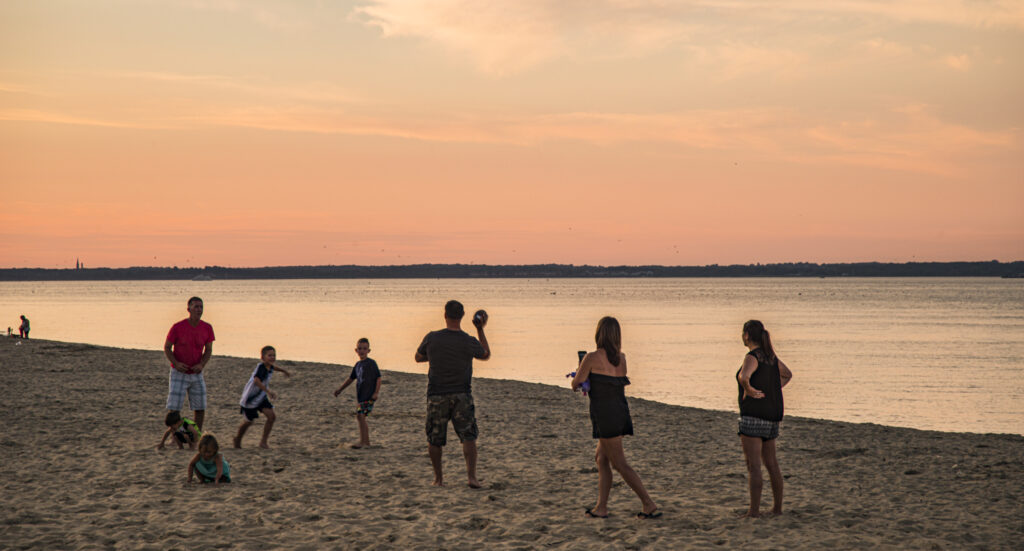
Posted by NWNL on January 20, 2024.
Transcription edited and condensed for clarity by Alison M. Jones.
All images © Alison M. Jones, unless otherwise noted. All rights reserved.
